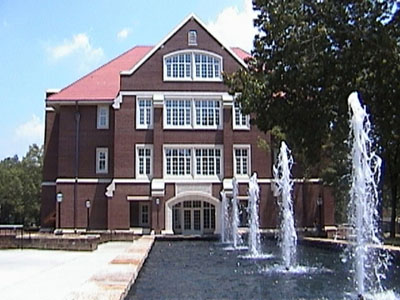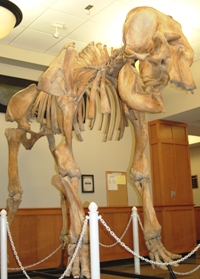 The Donald W. Reynolds Center for Life Sciences
The Donald W. Reynolds Center for Life Sciences
Funded with a $10.8 million grant from the Donald W. Reynolds Foundation, the center is home to the Biology and Psychology Departments. The Center opened for classes in January, 2001.
Tour our facilities
- Lower Level - three large lecture rooms and two small seminar rooms.
-
1st Floor - one large classroom, conference room, computer lab, seminar room and psychology faculty offices.
- 2nd Floor - botany, zoology, cell and ecology labs, herbarium, biology department library and biology faculty offices
- 3rd Floor - faculty research labs, undergraduate research lab, microbiology/immunology lab, genetics and physiology labs and biology faculty offices
- 4th Floor - faculty research labs, greenhouse, and biology faculty offices
Featured Displays in D. W. Reynolds Center
Elephant Skeleton
 Hendrix College displays the skeleton of a sub-adult female Asian elephant in the east lobby. The skeleton is that of Kate, a former circus performer who was retired to Riddle's Elephant and Wildlife Sanctuary near Conway after she suffered a broken hip. Sadly, Kate had to be euthanized due to complications from her injury.
Hendrix College displays the skeleton of a sub-adult female Asian elephant in the east lobby. The skeleton is that of Kate, a former circus performer who was retired to Riddle's Elephant and Wildlife Sanctuary near Conway after she suffered a broken hip. Sadly, Kate had to be euthanized due to complications from her injury.
Dr. Keith Sutton, former Hendrix Biology Professor, worked closely with Riddle's Elephant Sanctuary on various projects to help students learn about elephant anatomy, including the exhumation of an African elephant skeleton with the Comparative Anatomy class. Dr. Sutton passed away in 2001. As part of a memorial to him, Scott and Heidi Riddle donated this skeleton to the college. (Information provided by Dr. Kelly Agnew)
Alligator Gar
 Students, staff and visitors who enter the D.W. Reynolds Life Sciences Building from the west, walk into a foyer dominated by an enormous alligator gar. The gar has been a part of the Biology Department's collection since 1962. It's origins are in the St. Francis River in northeast Arkansas. After the St. Francis River flooded in 1913, the gar was stranded in a shallow pool created by the receding river. Greene County farmers "hogged" the fish out of the water and carried it to R.W. Meriwether, proprietor of the W.W. Meriwether and Son Hardware Store in Paragould. It was packed in ice and sent by rail to St. Louis, where it was preserved and mounted. The fish was a major attraction at the hardware store until the store closed in 1962. Shortly after, Robert W. Meriwether, grandson of R.W. and a Hendrix administrator and professor, brought the gar to Conway and had it cleaned, repaired and remounted. It is displayed in the west foyer.
Students, staff and visitors who enter the D.W. Reynolds Life Sciences Building from the west, walk into a foyer dominated by an enormous alligator gar. The gar has been a part of the Biology Department's collection since 1962. It's origins are in the St. Francis River in northeast Arkansas. After the St. Francis River flooded in 1913, the gar was stranded in a shallow pool created by the receding river. Greene County farmers "hogged" the fish out of the water and carried it to R.W. Meriwether, proprietor of the W.W. Meriwether and Son Hardware Store in Paragould. It was packed in ice and sent by rail to St. Louis, where it was preserved and mounted. The fish was a major attraction at the hardware store until the store closed in 1962. Shortly after, Robert W. Meriwether, grandson of R.W. and a Hendrix administrator and professor, brought the gar to Conway and had it cleaned, repaired and remounted. It is displayed in the west foyer.
This alligator gar, Lepisosteus spatula, is 7 feet 5 inches in length and weighed 161 pounds when it was captured. Based on size-age data, the "big fish" was more than 50 years old at the time it was captured. (Information provided by Dr. Chris Spatz.)